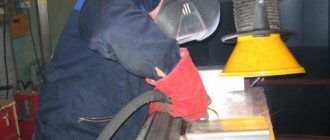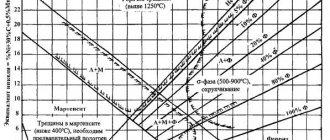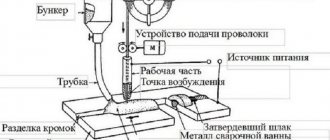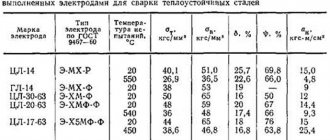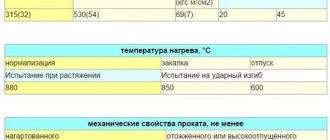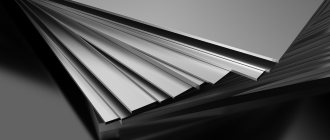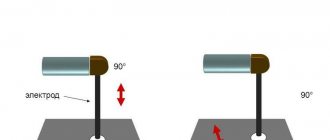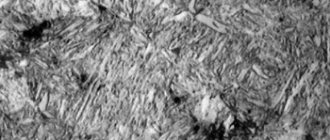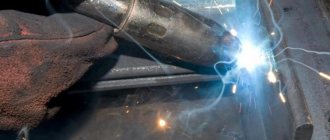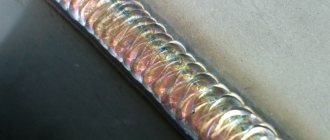Chemical composition and properties of steels
[context] In carbon structural steels, carbon is the main alloying element. The mechanical properties of steels depend on the amount of this element. Low-carbon steels are divided into steels of ordinary quality and high-quality ones.
Ordinary quality steel
Depending on the degree of deoxidation, ordinary quality steel is divided into:
- boiling - kp;
- semi-calm - ps;
- calm - sp.
Boiling steel
Steels of this group contain no more than 0.07% silicon (Si). Steel is produced by incomplete deoxidation of steel with manganese. A distinctive feature of boiling steel is the uneven distribution of sulfur and phosphorus throughout the thickness of the rolled product. If an area with sulfur accumulation enters the welding zone, it can lead to the appearance of crystallization cracks in the weld and the heat-affected zone. When exposed to low temperatures, such steel can become brittle. Having succumbed to welding, such steels can age in the heat-affected zone.
Calm steel
Mild steels contain at least 0.12% silicon (Si). Calm steels are obtained by deoxidizing steel with manganese, silicon, and aluminum. They are distinguished by a more uniform distribution of sulfur and phosphorus in them. Calm steels respond less to heat and are less prone to aging.
Semi-quiet steel
Semi-quiet steels have average characteristics between calm and boiling steels.
Carbon steels of ordinary quality are produced in three groups. Group A steels are not used for welding; they are supplied according to their mechanical properties. The letter “A” is not used in the designation of steel, for example “St2”.
Steels of groups B and C are supplied according to their chemical properties, chemical and mechanical, respectively. The letter of the group is placed at the beginning of the steel designation, for example BSt2, VSt3.
Semi-quiet steel grades 3 and 5 can be supplied with a higher manganese content. In such steels, the letter G is placed after the grade designation (for example, BSt3Gps).
For the manufacture of critical structures, ordinary steels of group B should be used. The manufacture of welding structures from low-carbon steels of ordinary quality does not require the use of heat treatment.
Quality steels
Low-carbon quality steels are supplied with normal (grades 10, 15 and 20) and increased (grades 15G and 20G) manganese content. High-quality steels contain a reduced amount of sulfur. For the manufacture of welding structures from steels of this group, hot-rolled steels are used, less often heat-treated steels. To increase the strength of the structure, welding of these steels can be carried out with subsequent heat treatment.
Low alloy steels
If special chemical elements are introduced into carbon steel that are not initially present in it, then such steel is called alloyed steel. Manganese and silicon are considered alloying components if their content exceeds 0.7% and 0.4%, respectively. Therefore, VSt3Gps, VSt5Gps, 15G and 20G steels are considered both low-carbon and low-alloy structural steels.
Alloying elements are capable of forming compounds with iron, carbon and other elements. This helps improve the mechanical properties of steels and reduces the cold brittleness limit. As a result, it becomes possible to reduce the weight of the structure.
Alloying a metal with manganese increases impact strength and resistance to cold brittleness. Welding joints made from manganese steels are characterized by higher strength under alternating impact loads. The resistance of steel against atmospheric and sea corrosion can be increased by alloying with copper (0.3-0.4%). Most low-alloy steels for the production of welding structures are used in the hot-rolled state. The mechanical properties of alloy steels can be improved by heat treatment, therefore some grades of steel for welded structures are used after heat treatment.
Welding of reinforcement connections and embedded parts of reinforced concrete structures
These Instructions apply to the production of welding work when making connections of reinforcement and embedded parts intended for reinforced concrete structures, and during the installation of prefabricated reinforced concrete elements, as well as to the acceptance of these works.
The design of welded joints, the class and grade of steel of the elements of welded joints must be indicated in the project.
Methods and technology for welding connections of reinforcement and embedded parts should be selected using table. 1 and 2.
Notes: 1. Connection designs given in table. 1 with numbers without letter indices, as well as those marked with *, are the most technologically advanced and therefore recommended.
2. Connection designs given in table. 1 with numbers provided with letter indices, as well as those marked with ** - are allowed.
3. Compounds noted in table. 1 sign ***, are allowed in the absence of contact butt machines only for connecting rods made of steel of class A-IV, and with a diameter of rods up to 20 mm and classes AI-A-III.
4. Compounds noted in table. 1 numbers 3; For, are allowed in the manufacture of reinforcement if there are no contact butt machines for rods with a diameter of 20 mm or more of classes AI-A-III.
5. The connection noted in the table. 1 number 116, can be used in the manufacture of embedded parts if there are no contact point machines.
Table 1
table 2
Instructions for choosing methods and technology for welding connections of reinforcement and embedded parts.
| Connection type (number according to table 1) | Characteristics of reinforcing steel | Position in | space | Required welding equipment | Welding method | |||
| Class | brand | axes of rods | seams | standard | ||||
| without modernization | with modernization | special | ||||||
| 1 1,6 | AI—A-III, A-IV, At-IV | Any | Horizontal | Horizontal | + | — | — | Contact butt |
| 1,a | AI—A-III | » | Same | Same | — | + | — | Same |
| 1,6 | A-IV | 80C | » | » | + | — | — | » |
| 1* | AI—A-IV | Any | » | » | + | — | — | » |
| 2 | P-3—P-7 | — | » | 1 | + | — | — | » |
| 3 | AI—A-III | Any | Lower | » | — | — | Bathroom in inventory copper form | |
| 3,a | AI—A-III | » | » | Same | + | — | — | Single-electrode arc bath in copper form (without reinforcement with a smooth inner surface) |
| 3,6 | AI—A-III | Any | Horizontal | Lower | + | — | — | Bathroom in inventory copper form |
| 3, in | AI—A-SH | » | Same | Same | + | — | — | Multi-electrode arc bath on composite steel pads (with continuous flow of slag) |
| 3,g | AI—A-III | » | » | » | + | — | — | Arc multilayer seams. Bathroom with d32 mm |
| 4 | AI—A-III | » | » | » | + | + | — | Bathroom in inventory copper form |
| 5 | AI—A-III | » | Vertical | » | + | + | — | Same |
| 5,a | AIA-III | » | Same | Vertical | + | — | — | Arc multi-layer seams on steel linings |
| 5,6 | AI—A-III | » | » | Same | + | — | — | The same, but without steel linings |
| Type of connections (number according to table 1) | Characteristics of reinforcing steel | Position in space | Required welding equipment | Welding method | ||||
| Class | brand | axes of rods | seams | standard | ||||
| without modernization | with modernization | special | ||||||
| 6,a | AI—A-IV | Any | Horizontal or vertical** | Bottom or vertical** | + | — | — | Arc seams |
| 6,6 | A-IV | Except 80C | Horizontal | Lower | + | — | — | Same |
| 6, in | AI—A-III | Any except St. 5, 18G2S and 35GS | Same | Same | + | — | — | Arc points |
| 6,g | AI—A-III | Any | Vertical or horizontal | Vertical or horizontal on a vertical plane | + | — | — | Arc seams |
| 7 and 8 | AI—A-III and BI | >> | Horizontal | Horizontal | + | — | + | Contact point |
| 7,a or 8,a | AI—A-III | Any except St. 5, 18G2S and 35GS | Horizontal or vertical | Bottom or semi-ceiling | + | — | — | Dugovaya |
| 9 | AI—A-III | Any | Vertical | Lower | — | — | + | Submerged arc |
| 9,a, 9,6, | AI—A-IV | Any except 80C | Same | >> | + | — | — | Arc seams |
| 10 | AI—A-IV | Same | Horizontal or vertical** | Bottom or vertical** | + | — | — | Same |
| 11 | AI—A-III | Any | Horizontal | Horizontal | + | — | — | Contact point |
| 11,a | AI—A-III | >> | >> | Same | + | — | — | Contact relief |
| 11,6 | AI—A-IV | Any except 80C | Horizontal or vertical** | Bottom or vertical** | + | — | — | Arc seams |
| 11, in | AI or A-III | Any except 35GS | Horizontal | Lower | + | — | — | Arc points |
| Type of connections (number according to table 1) | Characteristics of reinforcing steel | Position in space | Required welding equipment | Welding method | ||||
| Class | brand | axes of rods | seams | standard | special | |||
| without modernization | with modernization | |||||||
| 12,a | AI—A-III | Any | Horizontal | Bottom or vertical | + | — | — | Arc seams |
| 12,b 12,c | AI and A-II | Art. 3 and 10GT*** (except for steel St. 5, 18G2S) | Same | Lower | + | — | — | Arc points |
| 12,g | AI and A-II | Art. 3 and 10GT*** (except for steel St. 5, 18G2S) | Vertical | Vertical | + | — | — | Arc seams |
* Butt joints machined after welding. ** Except for class A-IV rods. ***At temperatures down to minus 40°C.
Note. + (plus) equipment recommended; — (minus) not recommended.
Welders who have undergone special training and passed control tests must be allowed to work on welding joints of reinforcement and embedded parts.
The welder, as a rule, must mark each design welded joint (at the location indicated on the drawing).
Welding of reinforcement connections and embedded parts elements should be carried out in compliance with the safety rules provided for by SNiP III-A.11-62 “Safety in Construction”.
Welding using faulty equipment is not allowed during unreliable electrical networks, power outages, as well as sudden (more than 5% of the optimal value) voltage fluctuations in the network; the last two conditions must be observed especially strictly when welding reinforcement joints.
Welding equipment and arc power sources must be certified every six months. Operation of welding equipment that does not have a passport or has expired certification is not allowed.
www.prosvarky.ru
Weldability of low-carbon and low-alloy steels
Low-carbon and low-alloy structural steels have good weldability. Their welding technology must ensure equal mechanical properties of the weld and the base metal (not lower than the lower limit of the properties of the base metal). In some cases, due to the operating conditions of the structure, a reduction in some mechanical properties of the seam is allowed. The seam must be free of cracks, lack of penetration, pores, undercuts and other defects. The shape and geometric dimensions of the seam must correspond to the required ones. Additional requirements may be imposed on the welded joint, which are related to the operating conditions of the structure. Without exception, all welds must be durable and reliable, and the technology must ensure the productivity and economy of the process.
The mechanical properties of a welded joint are influenced by its structure. The structure of the metal during welding depends on the chemical composition of the material, welding conditions and heat treatment.
Preparation and assembly of parts for welding
[context] Preparation and assembly for welding is carried out depending on the type of welding joint, welding method and metal thickness.
To maintain the gap between the edges and the correct position of the parts, specially created assembly fixtures or universal fixtures (suitable for many simple parts) are used. Assembly can be performed using tacks, the dimensions of which depend on the thickness of the metal being welded. The tack can be 20-120 mm long, and the distance between them is 500-800 mm. The cross-section of the tack is equal to approximately a third of the seam, but not more than 25-30 mm2. Tack welding can be done by manual arc welding or mechanized gas shielded welding. Before proceeding to welding the structure, the tacks are cleaned, inspected, and if any defects are present, they are cut out or removed by other methods. During welding, the tacks are completely remelted due to the possible occurrence of cracks in them as a result of rapid heat removal. Before electroslag welding, the parts are placed with a gap that gradually increases towards the end of the weld. Fixing the parts to maintain their relative position is done using staples. The staples should be at a distance of 500-1000 mm. They must be removed as the suture is applied. For automatic welding methods, lead-in and exit bars should be installed. With automatic welding, it is difficult to ensure high-quality penetration of the weld root and prevent metal burns. For this purpose, remaining and removable linings and flux pads are used. You can also weld the root of the seam using manual arc welding or semi-automatic welding in shielding gases, and the rest of the seam is performed using automatic methods.
Welding by manual and mechanized methods is performed by weight.
The edges of welding parts are thoroughly cleaned of slag, rust, oil and other contaminants to prevent the formation of defects. Critical structures are welded mainly on both sides. The method of filling the groove edges when welding thick-walled structures depends on its thickness and the heat treatment of the metal before welding. Lack of penetration, cracks, pores and other defects identified after welding are removed with a mechanical tool, air-arc or plasma cutting, and then welded back. When welding low-carbon steels, the properties and chemical composition of the welded joint largely depend on the materials used and welding modes.
Gas welding of steel.
Low-carbon steels can be welded using any gas welding method (both right and left). The burner flame (we read about the flame and its power in this article) when welding steel should be normal and with a power of 100 - 130 dm³/h of acetylene per 1 mm of metal thickness for left-hand welding and 120 - 150 dm³/h for right-hand welding. But highly qualified welders use a higher power flame of 120 - 150 dm³/h of acetylene per 1 mm of metal thickness, while using thicker wire, which increases productivity. In this case, the welder requires considerable experience, since incompetent welding can overheat the metal and result in a coarse-grained structure of the weld metal.
When gas welding carbon steels, low-carbon steel wire Sv - 08, Sv - 08A, Sv - 10GA is used (according to GOST 2246-60). When welding with this wire, part of the carbon, manganese and silicon burns out, and the weld metal acquires a coarse-crystalline structure and its tensile strength is lower than that of the base metal. Therefore, I advise you to use Sv-12GS wire, which contains 0.17% carbon, to obtain a weld that is not inferior in strength to the base metal; 0.8 - 1.1% manganese and 0.6 - 0.9% silicon.
When welding with a high-power flame, in order to avoid overheating of the metal, we reduce the angle of inclination of the mouthpiece and direct the flame more towards the end of the wire. When welding, I advise you to strive for simultaneous melting of the edges of the weld and the tip of the wire, so that drops of the molten filler metal of the wire do not fall on the insufficiently heated edge of the base metal. If this happens, then in this place there will be no strong connection between the deposited metal and the base metal and a lack of penetration of the edge will form. Often, when an inexperienced welder touches the edge of a metal with the tip of an insufficiently heated wire, it often welds (sticks) to the base metal.
To increase the compaction and ductility of the deposited metal, I advise you to forge the seam in a hot state. Forging is carried out at a temperature of light red heat and ends at a temperature of dark red heat. At a lower temperature, if forging is performed, cracks may form in the weld and adjacent areas of the base metal. When welding sheets of large thickness and critically loaded parts, before welding it is necessary to heat the part, then weld the part in several passes and after welding, achieve a slow cooling of the part by heating it with a torch or cutter and gradually reducing the heat.
Medium-carbon steels (up to 0.6% carbon) are less weldable than low-carbon steels. They are prone to warping and cracking when welded. We use a tip with a power of 75 dm³/h of acetylene per 1 mm of the thickness of the metal being welded, that is, less than when welding low-carbon steel. The flame should be normal or slightly carburizing, as oxidizing flames cause carbon to burn out. When the metal thickness is more than 3 mm, I recommend using general preheating of the welded products to 250 - 350 ° C to reduce uneven heating, reduce internal stresses and prevent hardening of the base metal in the weld area. It is advisable, along with general heating, to use local heating in the weld area up to 650 - 700 ° C.
For medium-carbon steels, wire Sv - 0.8A is used (according to GOST 2246-60), since the low carbon content in this wire reduces carbon burnout and boiling of the weld pool. Also, to avoid overheating of the metal, I advise you to use left-hand welding. After welding, it is advisable to forge the seam at 850 - 900°C, followed by normalization by heating to 900°C and cooling in air, but at positive temperatures. The structure of the weld metal and the metal zone near the weld can be improved (strengthened) by tempering when heated to 600 - 650 ° C. When welding steels containing 0.7 - 0.8% carbon, I recommend using borax flux. It should be noted that steels containing more than 0.6% carbon are welded much worse, and their high-quality welding can be obtained with a metal thickness of no more than 6 mm. When welding steel, the cleanliness of the surface of the edges is important, since contamination causes pores, slag inclusions and lack of penetration in the weld.
Welding alloy steels.
Most structural alloy steels can be welded satisfactorily by gas welding. Welding of these steels has a number of features due to the fact that alloying impurities partially burn out, as a result of which the weld metal loses its properties of steel of this grade. Alloy steels conduct heat less well than mild steels and are therefore subject to more warping when welded. Some grades of steel can be hardened in air, especially in the area near the seam, and are prone to cracking.
Low-alloy steels (for building structures), for example 15ХСНД or 10ХСНД, can be welded well by gas welding. We select the power of the tip approximately 75 - 100 dm³/h for left-hand welding and 100 - 130 dm³/h of acetylene for right-hand welding per 1 mm of steel thickness. When welding, we use a normal flame and wire Sv-08, Sv-08A, or Sv-10G2 (according to GOST 2246-60). Both left and right welding can be used. To improve the quality of the deposited metal, I advise you to forge the weld at light red heat (800-850°C) and then normalize the weld metal, but do not use flux.
Chromium steels can contain from 4 to 30% chromium. Gas welding of chromium steels has a number of difficulties, since they are prone to severe warping and hardening when the weld cools, which causes the formation of cracks. And the higher the carbon content in chromium steel, the worse it welds. We weld with a normal flame and a tip with a power of no more than 70 dm³/h of acetylene per 1 mm of metal thickness. We use wire from chromium-nickel steel Sv-02Х19Н9, but better results can be obtained by using wire Sv-06Х19Н9Т, where the letter T means titanium, and N means niobium. Titanium and niobium prevent the formation of solid chemical compounds of chromium and carbon (chromium carbides) in the weld. Welding should be carried out as quickly as possible, trying to avoid interruptions and repeated heating of the seam. To avoid overheating and cracks, one-sided single-layer (single-pass) welding should be used. When welding, we use flux, which protects chromium from fading and helps remove chromium oxides from the weld. Flux composition: boric acid 55%, silicon oxide 10%, ferromanganese 10%, ferrochrome 10%, ferrotitanium 5%, titanium ore (concentrate) 5% and fluorspar 5%. Before welding, we clean the edges to a metallic shine. Before gas welding of chromium steels, the parts should be heated to only 200-250°C, and after welding, the metal should be tempered by heating.
Gas welding of chromium-nickel stainless steels . These steels are welded with a normal flame and a power of 75 dm³/h of acetylene per 1 mm of metal thickness. Oxidizing flames are not permitted. We use wire Sv-02Х19Н9, Sv-06Х19Н9Т or Sv-08Х19Н10Б. When welding heat-resistant stainless steel, we use wire containing 21% nickel and 25% chromium. For welding stainless, corrosion-resistant steel that contains molybdenum, we use wire containing 3% molybdenum, 11% nickel, and 17% chromium.
Gas welding of stainless steels must be carried out quickly, keeping the end of the wire in the weld pool at all times. I advise you to weld on a copper lining for better heat dissipation. Both left and right welding can be used. For long seams, we use a reverse-stage welding method, and hold the torch nozzle at an angle of 45° to the surface of the part. After welding, the part must be subjected to heat treatment, that is, hardening by heating to 1050 - 1100 ° C and rapid cooling in water. Hardening can be replaced by annealing at a temperature of 850°C and cooling in air. This must be done so that the chromium carbides released during welding, which give the steel corrosion resistance, dissolve again in the alloy and the weld acquires the properties of the base metal (including corrosion). Steel with titanium additives does not need to be subjected to heat treatment after welding.
To improve the appearance of the seam and remove chromium oxides, a flux of 80% fluorspar and 20% ferrotitanium is used. A flux made from more common components is also suitable, namely: 50% borax and 50% boric acid, as well as 80% borax and 20% silicon dioxide. We apply flux to the cleaned edges 15 - 20 minutes before welding, and after welding we remove the remaining flux by rinsing with a brush in hot water. But if you can find NZh-8 flux paste on sale, which does not contain boron and fluorine, which cause weld corrosion, then you don’t have to wash the part after welding. This flux paste contains marble, porcelain, ferromanganese, ferrosilicon, ferrotitanium, and titanium dioxide.
It is better to weld chromium-nickel steels using gas-shielded arc welding, since these methods provide a smaller heating zone and therefore provide better quality of the weld than gas welding. Using gas welding, I advise you to weld stainless steel with a thickness of no more than 3 mm, since with a larger thickness of steel its deformation reaches a significant value.
If this article is useful to you, please share it on social media. networks by clicking the buttons below. Thank you.
RќСЂР°РІРёС‚СЃСЏ
Manual arc welding of low-carbon steels
To obtain a high-quality connection using manual arc welding, it is necessary to choose the right welding electrodes, set the modes and apply the correct welding technique. The disadvantage of manual welding is the high dependence on the experience and qualifications of the welder, despite the good weldability of the steels in question.
Welding electrodes should be selected based on the type of steel being welded and the purpose of the structure. To do this, you can use the electrode catalog, where the passport data of many brands of electrodes is stored.
In the catalog of electrodes, see the section electrodes for welding carbon and low-alloy steels.
When choosing an electrode, you should pay attention to the recommended conditions for the type and polarity of the current, spatial position, current strength, etc. The passport for the electrodes may indicate the typical composition of the deposited metal and the mechanical properties of the connection made by these electrodes.
You can read more about the modes and techniques of manual arc welding here:
- Manual arc welding
- Manual arc welding modes
In most cases, welding of low-carbon steels is carried out without measures aimed at preventing the formation of hardening structures. But still, when welding thick-walled fillet welds and the first layer of a multilayer weld, preheating the parts to a temperature of 150-200 ° C is used to prevent the formation of cracks.
When welding non-heat-strengthened steels, a good effect is achieved using cascade and slide welding methods, which does not allow the weld metal to cool quickly. Preheating to 150-200° C gives the same effect.
For welding heat-strengthened steels, it is recommended to make long seams along cooled previous seams in order to avoid softening of the heat-affected zone. You should also choose modes with low heat input. Correction of defects during multilayer welding should be done with large-section seams, at least 100 mm long, or the steel should be preheated to 150-200 ° C.
Gas shielded arc welding of low carbon steels
Welding of low-carbon and low-alloy steels is carried out using carbon dioxide or its mixtures as a shielding gas. You can use mixtures of carbon dioxide + argon or oxygen up to 30%. For critical structures, welding can be performed using argon or helium.
In some cases, carbon and graphite electrode welding is used for welding on-board connections with a thickness of 0.2-2.0 mm (for example, capacitor housings, canisters, etc.). Since welding is performed without the use of a filler rod, the content of manganese and silicon in the weld is low, resulting in a loss of joint strength that is 30-50% lower than that of the base metal.
Carbon dioxide welding is performed using welding wire.
For automatic and semi-automatic welding in different spatial positions, wire with a diameter of up to 1.2 mm is used. For the lower position, use a 1.2-3.0 mm wire. Table 1. Selection of wire for gas-shielded welding of low-carbon and low-alloy steels
| Steel | Vst1, Vst2 | VSt3 | 10HSND, 15HSND, 14HGS, 09G2, 14G2 and the like |
| Wire | Sv-08GS, Sv-08G2S, Sv-12GS | Sv-08GS, Sv-08G2S | Sv-08G2S (for one- and two-layer welding), sv-08HG2S |
As can be seen from the table, Sv-08G2S wire can be used for welding all steels.
Submerged arc welding of low carbon steels
A high-quality welded joint with equal strength of the seam and the base metal is achieved through the correct selection of fluxes, wires, welding modes and techniques. It is recommended to perform automatic submerged arc welding of low-carbon steels with wire with a diameter of 3 to 5 mm, semi-automatic submerged arc welding with a diameter of 1.2-2 mm. For welding low-carbon steels, AN-348-A and OSTS-45 fluxes are used. Low-carbon welding wire of the Sv-08 and Sv-08A grades, and for critical structures you can use Sv-08GA wire. This set of welding consumables makes it possible to obtain welds with mechanical properties equal to or exceeding those of the base metal.
For welding low-alloy steels, it is recommended to use welding wire Sv-08GA, Sv-10GA, Sv-10G2 and others containing manganese.
Fluxes are the same as for low-carbon steels. Such materials make it possible to obtain the necessary mechanical properties and resistance of the metal from the formation of pores and cracks. When welding without bevel, increasing the proportion of base metal in the weld metal can increase the carbon content. This increases the strength properties, but reduces the plastic properties of the connection. Table 1. Consumables for submerged arc welding of low-carbon and low-alloy steels
| steel grade | Fused flux grade | Welding wire |
| VSt1-VSt3 | AN-348-A, OSTS-45, FC-9 and ceramic K-11, KVS-19 | Sv-08, Sv-08A, for critical structures Sv-08GA |
| 09G2 | AN-22 | Sv-08GA |
| 12GS, 16GS, 10G2S1, 17GS, 17G1S | AN-60 | Sv-GSMT (for steel 12GS also Sv-10GA) |
| 09G2S | AN-22 | Sv-08GA, Sv-10NMA, Sv-10GA |
| 10HSND | AN-348-A | Sv-08GSMT |
| 15HSND | AN-348-A, AN-22 | Sv-10G2, Sv-08HGSMA |
Welding modes for low-carbon and low-alloy steels differ slightly and depend on the welding technique, type of joint and seam.
When welding single-layer fillet welds, fillet and butt welds of thick steel grade VSt3 in modes with low heat input, hardening structures can form in the heat-affected zone and ductility may decrease. To prevent this, the cross-section of the seam should be increased or double-arc welding should be used. Table 2. Relationship between metal thickness and weld layer cross-section
| Sheet thickness, mm | 8-10 | 10-22 | 24-60 |
| Cross-section of the layer formed from electrode metal, mm | 25 | 35 | 50 |
To prevent weld destruction in the heat-affected zone when welding low-alloy steels, modes with low heat input should be used, and for welding non-heat-strengthened steels, modes with increased heat input should be used. In the second case, to ensure the plastic properties of the seam and adjacent zone are no worse than the base metal, it is necessary to use double-arc welding or preheating to 150-200 ° C.
Content
- The essence of the submerged arc welding process
- Welding patterns
- Features of submerged arc welding
- The role of flux in welding
- Submerged arc welding methods
- Laser welding technology
- Types of welds produced by submerged arc welding
- Submerged arc welding modes and techniques
- Butt welding
- Welding T-, fillet and overlap welds
- Welding of structural carbon steels
- Welding low alloy steels
- Welding of medium alloy steels
- Welding of high alloy steels
